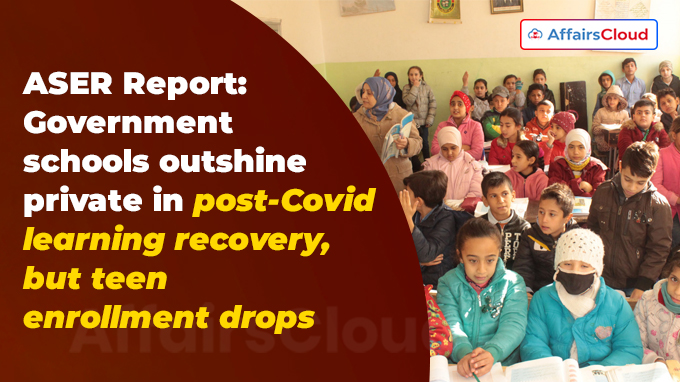 In January 2025, the Non-Governmental Organisation (NGO) Pratham Foundation released the “Annual Status of Education Report(Rural) 2024 (ASER 2024)”, a nationwide household survey that covers the status of children’s enrolment and learning outcomes in rural India annually. The report highlighted that enrolment in both government and private schools has returned to pre-COVID levels.
In January 2025, the Non-Governmental Organisation (NGO) Pratham Foundation released the “Annual Status of Education Report(Rural) 2024 (ASER 2024)”, a nationwide household survey that covers the status of children’s enrolment and learning outcomes in rural India annually. The report highlighted that enrolment in both government and private schools has returned to pre-COVID levels.
- However, the report noted that the government schools outshined private schools in Post-COVID learning recovery levels.
- The report showed that government schools, which saw a surge in enrolment for children aged 6-14 during the pandemic, are now returning to pre-pandemic levels, decreased from 72.9% (in 2022) to 66.8% (in 2024). This trend can be seen in every state, except: Uttarakhand and Jammu & Kashmir (J&K).
About ASER Report 2024:
i.Since 2005, the survey was conducted by Pratham Education Foundation in collaboration with local organisations and institutions in each district.
- In 2016, ASER switched to an alternate-year model.
ii.The survey used the framework of the 2011 Census to randomly select 30 villages from each district, and 20 households from each village.
iii.The survey was conducted for children which has categorised them into 3 main age groups: Pre-Primary (age group 3-5), Elementary (age group 6-14), and Older Children (age group 15-16).
iv.The survey generated district, state, and national level estimates of children’s enrollment status and their basic reading and arithmetic skills.
Key Findings of ASER 2024:
The household-based Survey ASER 2025 has covered almost covered 649,491 children aged 3-16, in 17,997 villages across 605 districts of 29 States/Union Territories (UTs) of India.
Pre-Primary (age group 3-5 years):
i.Enrolment in pre-primary institutions: The report observed that enrolment in some type of pre-primary institutions such as Anganwadi centre, government pre-primary class, among others, among children aged 3-5 years has improved steadily between 2018 and 2024.
- Enrolment in pre-primary institutions among 3-year olds has increased from 68.1% (in 2018) to 75.8% (in 2022) to 77.4% (in 2024). Gujarat, Maharashtra, Odisha and Telangana have achieved near-universal enrolment for this age group.
ii.Type of Pre-Primary Institution: Since 2018, over 50% of children aged 3 and 4 are enrolled in Anganwadi centres.
- Over 75% of children are enrolled in Anganwadi centres in both these age groups in states like: West Bengal (WB), Gujarat, and Karnataka.
- Nearly 33% (1/3rd) of all 5-year olds students attend a private school or pre-school in 2024 .Enrolment in these pre-schools decreased from 37.3% (in 2018) to 30.8% (in 2022) and again increased to 37.5% (in 2024).
- However, enrolment in government institutions has increased significantly in states like: Punjab (11.2% points) and J&K (7.6% points) since 2018.
iii.Age of Entry to Class I: The overall percentage of children who are ‘underage’ (age 5 or below) enrolled in Class I has decreased to 16.7%, the lowest level ever recorded.
Elementary (age group 6-14 years):
Enrolment Trends: The overall percentage of school enrolment for 6 to 14 year-olds increased to more than 95% for nearly 20 years.
- This proportion has remained almost the same, from 98.4% (in 2022) to 98.1% (in 2024).
Reading:
The data of the report indicates that reading levels have improved for children in government schools in all elementary grades since 2022.
i.ClassIII: The percentage of Class III students in government schools who can read a Class II textbook, decreased from 20.9% (in 2018) to 16.3% (in 2022) and then increased to 23.4% (in 2024). This indicates that 76.6% of Class III students were unable to read texts, which were provided in 19 different languages.
- The reading level in government schools of Uttar Pradesh (UP) has increased from 12.3% (in 2018) to 27.9% (in 2024).
- Apart from UP, states like: Haryana, Himachal Pradesh (HP), Uttarakhand, Maharashtra and Odisha recorded a 10% increase in reading levels between 2022 and 2024.
ii.Class V: The percentage of Class V students in government schools who can read a Class II textbook increased from 38.5% (in 2022) to 44.8% (in 2024).
- While, reading levels for Class V children in private schools, which declined from 65.1% (in 2018) to 56.8% (in 2022) and increased to 59.3% (in 2024).
- Mizoram (64.9%) had the highest percentage of Class V children in government schools able to read Class II text-books, followed by HP (64.8%).
iii.Class VIII: The percentage of Class VIII students in government schools who can read a Class VIII textbook increased from 66.2% (in 2022) to 67.5% (in 2024). The performance of private school students remained the same between 2022 and 2024.
- Government schools in states like: Gujarat, UP, and Sikkim witnessed notable improvements in reading levels for Class VIII students.
Arithmetic:
The report showed that the basic arithmetic level of children at national-level has improved significantly in both government and private schools, reaching the highest level in over a decade.
i.Class III: The overall percentage of students in Class III who are able to at least do a numerical subtraction problem, decreased from 28.2% (in 2018) to 25.9% (in 2022) and then increased to 33.7% (in 2024).
ii.Class V: The overall percentage of students in Class V who are able to at least do a numerical division problem increased from 25.6% (in 2022) to 30.7% (in 2024). This increase is attributed mainly by the government schools.
iii.Class VIII: The performance of Class VIII students in basic arithmetic has increased marginally from 44.7% (in 2022) to 45.8% (in 2024).
Drop- out Rate :
The drop-out rate for children aged 15-16 has declined sharply from 13.1% (in 2018) to 7.5% (in 2022) but remained the same at 7.9% (in 2024) at national level.
- The survey showed that the drop-out rate for girls, increased marginally from 7.9% (in 2022) to 8.1% (in 2024).
- However, some states witnessed decline in the percentage of drop-out for girls: Madhya Pradesh (MP) (16.1%), Uttar Pradesh (UP) (15%), Rajasthan (12.7%), among others.
Digital Literacy:
The survey included a digital literacy section for the 1st time, to assess the digital literacy awareness among children aged 14-16.
i.Access: The report found that almost 90% of both girls and boys among the age group of 14-16 have access to smartphones at home.
- The proportion of those who have access to smartphones and those who can use smartphones is lower for states like: MP, Jharkhand and Bihar compared to other states.
ii.Ownership: The report highlighted that personal ownership of smartphone among 14-16 year-olds has increased from 19% (in 2022) to 31% (in 2024).
- 27% of 14-year-olds and 37.8% of 16-year-olds reported having their own phone.
- Among 14-16 years-olds, 36.2% of boys and 26.9% of girls reported having their own smartphone.
iii.Use: 82.2% of the children aged 14-16 reported knowing how to use a smartphone (85% of boys as compared to 79.4% of girls).
- Of these, 57% reported using it for an educational activity and 76% for the social media activity during the same period.
iv.Digital Safety: 62% of children aged 14-16 knew how to block or report a profile and 55% knew how to make a profile private.
v.Digi Skills: The report showed that 70.2% boys and 62.2% girls were able to bring a smartphone to do the digital tasks.
- The report noted that boys outperform girls across most states in digital skills, except in states like: Kerala and Karnataka, where girls match or outperform boys.
School Observations:
i.Foundational Literacy and Numeracy (FLN) activities: More than 80% of schools received a directions from the government to implement FLN activities with Class I-II/III both in the last as well as the current academic year.
ii.Student and Teacher Attendance: The average attendance of teachers increased from 85.1% (in 2018) to 87.5% (in 2024), and the average attendance of students increased from 72.4% (in 2018) to 75.9% (in 2024).
iii.Small Schools and Multigrade Classrooms: The proportion of government primary schools with less than 60 students enrolled, increased from 44% (in 2022) to 52.1% (in 2024).
- Over 80% of primary schools in states like: J&K, Uttarakhand, Nagaland and Karnataka, are small schools.
iv.School Facilities: As per the report, only 72% schools have usable girls’ toilets, increase from 66.4% (in 2018), while 77.7% schools have drinking water facilities.
- Sports facilities show little improvement; with just 66.2% of schools having playgrounds in 2024, a slight decrease from 66.5% (in 2018).
About Pratham Education Foundation:
Chief Executive Officer (CEO)- Rukmini Banerji
Headquarters- Mumbai (Maharashtra), New Delhi (Delhi)
Established- 1995




